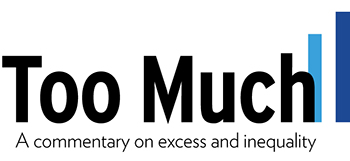‘Soak the rich,’ after years in the shadows, has suddenly become a policy option fit for discussion in ‘respectable’ media circles.
By Sam Pizzigati
At long last, we may be witnessing a fundamental paradigm shift in how we, as a society, talk about taxing the rich.
Until this summer, no national pundit — at least no pundit in good standing with the chattering class — would ever dare suggest a federal tax rate on America’s top income bracket higher than 39.6 percent, the level in place under Bill Clinton.
Now pundits and the policy wonks who hover around them are openly singing the praises of top tax rates calibrated at 50 or 60 or even 70 percent, a level that would double the current 35 percent rate on top-bracket income.
Who deserve the credit for this abrupt turnaround? That honor unquestionably belongs to James Surowiecki, the New Yorker magazine’s top economic analyst.

The New Yorker occupies a rather unique role in the modern America media echo chamber. The magazine’s high-brow readership and legendary reputation for rigorously fact-checked accuracy lend enormous credibility to any outside-the-mainstream point of view that gets expressed in the New Yorker‘s pages.
In the August 16 New Yorker, analyst Surowiecki aggressively advanced just such an outside-the-mainstream point of view — on taxing the extraordinarily wealthy. Our current approach to taxing the awesomely affluent, he wrote in a piece entitled Soak the Very, Very Rich, “makes no sense.”
Under this current system, Surowiecki pointed out, a successful dentist who makes $200,000 a year pays taxes at about the same rates as someone who makes $200 million.
We have in America today, Surowiecki’s New Yorker analysis would go on to add, “a yawning chasm between the professional and the plutocratic classes, and the tax system should reflect that.”
That reflection could be easy. Lawmakers, noted Surowiecki, would merely need to create new tax brackets for higher amounts of income, starting with a new and higher tax rate on income over $1 million. But, as his New Yorker piece quickly observed, lawmakers would have “no reason to stop there.”
Last week, CNBC gave the influential Center for American Progress, the Washington think tank led by a former Bill Clinton White House chief of staff, an opportunity to suggest how much further lawmakers should go. The Center’s Michael Linden suggested added tax brackets for income over $1 million, $5 million, and $10 million.
Someone making $500,000 a year, explained Linden, shouldn’t be paying “the exact same marginal tax rate on their last dollar of earnings as somebody making $10 million or $50 million.”
Time magazine’s Stephen Gandel, in his reaction to the New Yorker analysis, would stress the multiple benefits of soaking the rich. A “super tax rate for the super rich,” he noted, wouldn’t just “redistribute some of that wealth at the very high end of the income ladder to social programs that end up improving education or paying for healthcare reform or creating jobs.”
A super tax on super incomes, Gandel explained, would also help fix what ails our economy, by reducing “that global pool of money that sloshes around our financial markets and creates all types of bubbles.”
All “that money concentrated with the rich,” the Time analyst pointed out, “makes our economy prone to booms and busts, and less stable.”
The Washington Post, for its part, reacted to the wonky uproar that Surowiecki’s New Yorker column created by quizzing a cross section of tax experts and politicos on how high a super tax rate on super incomes should go.
The University of Michigan’s Joel Slemrod, in response, put the optimum top rate at “60 percent or higher.” Emmanuel Saez from the University of California, the nation’s top expert on high incomes, opted for 69 percent top federal rate. Dean Baker, from the Center for Economic and Policy Research in Washington, D.C., suggested “somewhere around 70 percent and possibly a bit higher.”
 The Post also put the same question to conservative analysts. Even one of them, former Reagan adviser Bruce Bartlett, called for a rate — at 50 percent — substantially higher than the current 35 percent U.S. top rate.
The Post also put the same question to conservative analysts. Even one of them, former Reagan adviser Bruce Bartlett, called for a rate — at 50 percent — substantially higher than the current 35 percent U.S. top rate.
Robert Reich, the former U.S. labor secretary, last week shoved history into this spirited new tax-the-rich debate. How about, Reich mused in a nationally circulated column, setting the top tax rate at 91 percent, the level where that rate stood back during the 1950s under Republican President Dwight D. Eisenhower?
That 91 percent rate applied to income over $400,000, the equivalent of about $3 million in today’s dollars. The rich, no surprise, loathed that rate. With that rate in effect, they felt their plutocratic power fading away fast.
“The United States Government makes the old ‘Robber Barons’ look like children,” multi-millionaire Richard Lounsbery, the heir to a mining fortune, fumed to the New York Times in 1959. “And there’s no difference between the Republicans and the Democrats, either. The Republicans are Socialists and the Democrats are Communists — that’s all.”
Middle class Americans, in the meantime, did just fine in a 91 percent top-tax-rate America. The mid 20th century would see the incomes of average Americans double, after taking inflation into account. “Soaking the rich” helped nurture a middle class Golden Age.
Apologists for America’s staggeringly unequal status quo, until this summer, had good reason to think that history forgotten. Now they have reason to worry. History remembered, after all, can become history repeated.
Sam Pizzigati edits Too Much, the online weekly on excess and inequality published by the Washington, D.C.-based Institute for Policy Studies. Read the current issue or sign up to receive Too Much in your email inbox.



Discussion
No comments for “In the Tax Debate: A Blast of Fresh New Air”